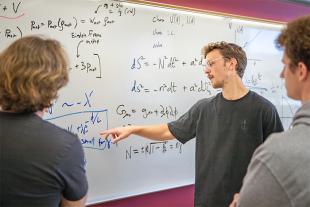Ask an Expert: What’s So Special About the SpaceX Launch?

This week, SpaceX is scheduled to perform the second crewed launch of its Crew Dragon spacecraft to the International Space Station (ISS). The mission, piloted by Cal Poly alumnus Victor Glover, has the potential to change the way humankind pursues the future of space exploration.
Kira Abercromby is a professor in Cal Poly’s Aerospace Engineering Department teaching human space flight — the study of how humans interact with spacecraft and respond to the space environment. Prior to teaching at Cal Poly, she worked for eight years at NASA’s Johnson Space Center. She spoke with Cal Poly News about what makes the upcoming mission so important.

What's different about this mission compared to a typical NASA mission?
It's really only the second flight with humans in this capsule. Once you put humans inside a capsule, the whole safety-conscious part of it goes through the roof. Obviously, you don't want to ever lose your rocket, but that loss is easier to deal with than a loss of a human crew.
It took a while to get the Dragon to the point that it could finally carry people on board. It had its first mission with two crew members a few months ago, and they had a very successful mission. Now instead of two people, it's four. There's nothing routine about what's happening on this mission. And to be honest, there shouldn't really ever be anything routine about whenever you send humans to space.
What in particular is different about this ship and way it was developed?
It was done with NASA funding, but it was done as a commercial entity. Although Boeing and Lockheed have done this in the past, it was in the context of NASA being very involved in every single design decision.
With Dragon, they had to meet NASA’s design requirements, but NASA wasn't involved in every single decision that was made for the design. SpaceX is also more in charge of the launch — that isn’t going through Houston. SpaceX is in charge of the entire mission control that usually goes through NASA.
What does that type of partnership mean for the way space travel might be pursued in the future?
Dragon is not going to the moon. It's not ferrying people to Mars. It's very much a transportation system to and from ISS. And that is really where NASA means for commercialization of space to go, because it then allows NASA to go interplanetary, and that's been needed for a long time.
The last time we landed up anybody on the moon, I was an infant, and that is not where we want it to be. The next push is for us to be able to go back, as a country, to the moon and then to Mars, and NASA needs to get out of lower orbit.
So you're saying that this frees up NASA's resources to focus on going beyond where we’ve already been?
Yeah, eventually. That's the idea if you can commercialize lower orbit, whether that's with Boeing or SpaceX or Blue Origin.
What else does privatization of low Earth orbit travel do for mankind?
What I believe SpaceX does really, really well is to get people involved in the mission who haven't paid attention to space in the past. They have an ability to make it seem like every single person who's watching their feed is a part of what's happening. A lot of those people haven't paid attention to space flight in a long time.
We used to joke when I was working at NASA that if we run the Shuttle mission and it ends up on page five, that was a great day for us, because if we ended up on page one, something bad had happened. Now anytime SpaceX launches, they're not on page five. It's new and it's exciting.
It’s kind of like what the Apollo program did. It creates another generation of people who want to work in space. It creates another generation of people who want to explore STEM.
What are you going to be watching for at the launch this weekend?
First and foremost is the safety of the crew. You will hear a lot of calls coming through that are about safety of the crew. They won't say those exact words, but they're not going to launch unless everything looks good. You can delay this launch for another month if you need to, if it means that crew’s still going to be safe.
After that, I'll be honest, I hold my breath for a while. It feels like about the whole eight minutes until they are at the second separation, because each one of those stages is very difficult. Then you can take this deep breath.
Then the next part is rendezvous between the vehicle and the ISS. They do that really slowly because if they mess that up, you have two spacecraft crashed and that's obviously not going to be good.
And then reentry, and then the whole time in space and all of it. It's all critical. SpaceX and NASA are going to hopefully make this look really easy, and it's not. It's really difficult and it's really complicated. It doesn't make it any less hard just because you don't have accidents. It just means you're doing it really well.
What's the value of going back to the ISS, of making that trip again and again?
There are a lot of lessons we can get for an interplanetary flight. Once you’re in space, it's not easy to get back, so it’s really important to have that full aspect of learning about humans and how we're going to do this for a much longer duration. The Mars mission would be nine months. That's a long time. Anything they can learn now on the psychological aspect of being in space is a benefit.
Then there's a lot of scientific work that we can do in space right now. For example, there are certain kinds of DNA sequencing that you wouldn't be able to do on the ground and see results fast enough. All of that kind of stuff is happening in orbit. It's really a great scientific test bed for the next step, which is getting off the surface of the planet and really far away.
Why should we be reaching for that next step, the next planet, and expanding our boundaries out there?
Well, I don't think you can actually overstate the fact that humans are natural explorers. It's what we've done from the beginning of time. We like to explore and learn and find out. Anything that you can do to push that envelope of exploration is only going to bring back positive results to the rest of the world.
It might seem like a small thing, but if you can excite fourth graders right now to stay in STEM, whether they become an astronaut or not, they could become the next person who solves another major scientific problem because they got excited about math and science watching the Dragon launch. That’s a big part of what makes this launch so exciting.
Photo above: Mission Specialist Shannon Walker, Pilot Victor Glover, Crew Dragon Commander Michael Hopkins – all NASA astronauts – and Japan Aerospace Exploration Agency (JAXA) astronaut and Mission Specialist Soichi Noguchi are seated in SpaceX’s Crew Dragon spacecraft during crew equipment interface training. Photo courtesy of NASA.




